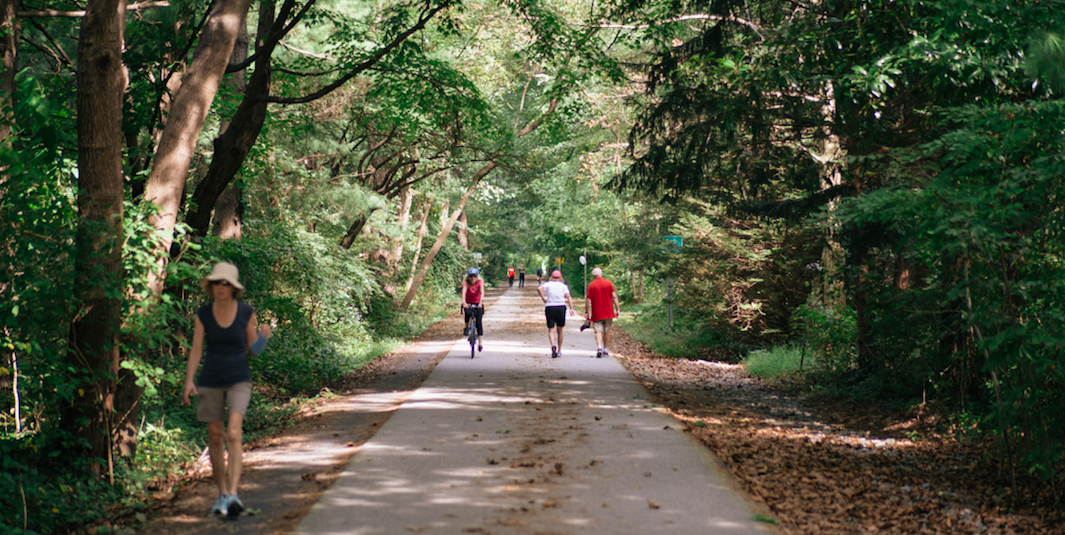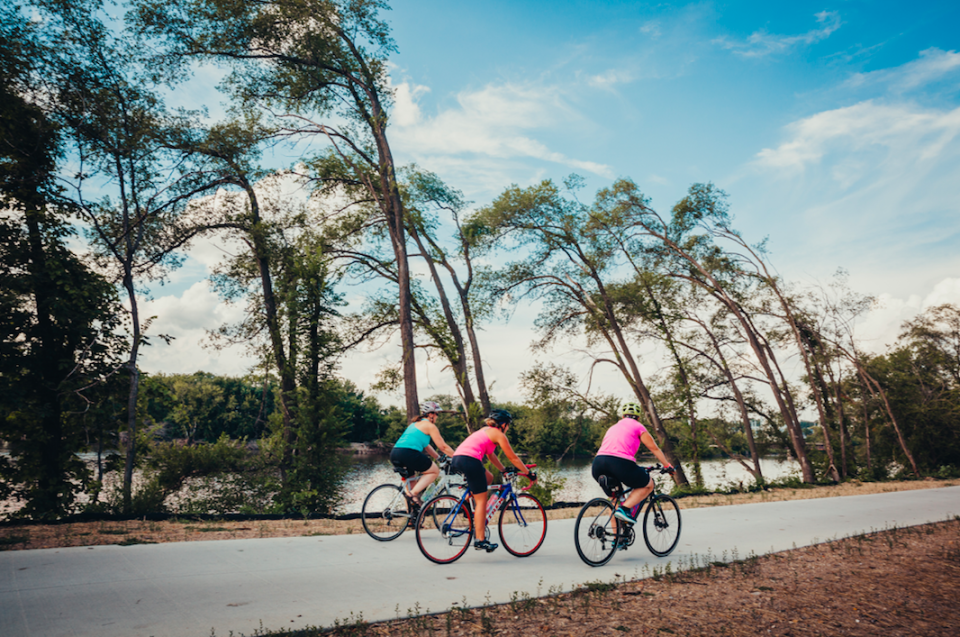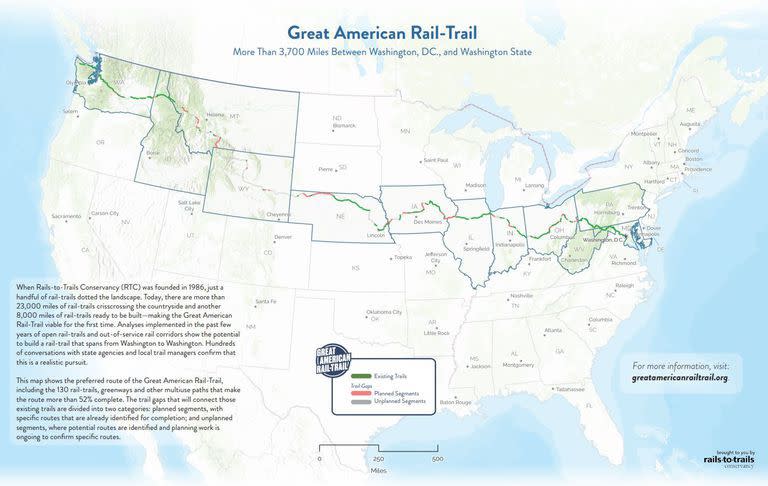The 4,000-Mile Trail System That Will One Day Connect Both Coasts Is Closer Than Ever

Four months after the coast-to-coast rail trail system was announced, the Rails-to-Trails Conservancy released the full route in a report shared with Bicycling.
The route will connect more than 125 existing trails and 90 trail gaps over more than 3,700 miles between Washington, D.C., and Washington state.
The trail will be multi-use for cyclists, runners, walkers, and skaters. Though it is more than half finished, it is still estimated to be decades from full completion.
For centuries, explorers have attempted to cross the United States in the most efficient ways available to them. Now for the first time in history, both coasts will be connected by a trail that will stretch almost 4,000 miles across the country. While the path will not be complete for years, trail goers can look forward to exploring the full route which was unveiled today.
Four months after the Rails-to-Trails Conservancy (RTC) announced the Great American Rail-Trail initiative, the organization shared the preferred route that will connect more than 125 existing trails and 90 trail gaps over more than 3,700 miles between Washington, D.C., and Washington state. The Great American Rail-Trail will be multi-use, with public trails available for activities such as cycling, walking, wheelchair use, inline skating, cross-country skiing, and horseback riding.
“Since the 1980s, RTC has understood the potential of a trail like the Great American Rail-Trail that could connect the nation. That vision has been a guidepost for the organization for 30 years. Now, we have the chance to create from that vision a national treasure that unites millions of people over thousands of miles of trail,” Ryan Chao, president of RTC, said in a statement. “This trail is a once-in-a-lifetime opportunity to provide-together-an enduring gift to the nation that will bring joy for generations to come.”
The route, which was determined after a 12-month analysis, was unveiled in a report that was shared with Bicycling and outlines the preferred trail that was developed in collaboration between the conservancy and state and local planners. The trail will run through 12 states–Washington D.C. and Maryland, Pennsylvania, West Virginia, Ohio, Indiana, Illinois, Iowa, Nebraska, Wyoming, Montana, Idaho, and Washington–and is currently 52.4 percent complete. Using a database of more than 34,000 miles of existing, multi-use trails nationwide, the RTC worked to identify a route that is more than 80 percent off-road and separate from vehicle traffic.

“When defining the preferred route of the Great American Rail-Trail, we sought a cross-country route that would provide the highest-quality experience while delivering significant economic and social benefits to the communities it connects,” Liz Thorstensen, vice president of trail development at RTC, said in a statement. “This route achieves those things and more, in large part thanks to the input, support and leadership of state agencies and local partners who have built the existing trails that will make the Great American Rail-Trail possible, and whose ongoing collaboration is vital to its completion.”
[Want to fly up hills? Climb! gives you the workouts and mental strategies to conquer your nearest peak.]
The beginning of the preferred route in Washington, D.C., is the only portion of the trail that is currently 100 percent complete. The trail begins on the steps of the U.S. capitol and continues on the Capital Crescent Trail in Georgetown. From there, the path runs through the Chesapeake and Ohio Canal National Historical Park, which eventually meets with the Great Allegheny Passage in Maryland.
In Pennsylvania, the route connects several existing trails through Pittsburgh and eventually traverses the Industrial Heartland Trails Coalition (IHTC), a proposed 1,500-mile network of trails that will stretch across 51 counties in four states (Pennsylvania, West Virginia, Ohio, and New York).
The Great American Rail-Trail continues through West Virginia for the lowest number of miles in any state on the route (4.1-mile trail gap), which runs along the Cleveland-to-Pittsburgh portion of the proposed IHTC trail network.
The Ohio & Erie Canalway Towpath Trail and the Ohio to Erie Trail are part of the Ohio state crossing, which will lead into a diagonal path across the state of Indiana. One hundred and fifteen miles of trail gaps will need to be filled in Indiana before the trail enters Illinois. In Illinois, the route will run through the Great Illinois Trail, before reaching the Hennepin Canal Parkway and Illinois & Michigan Canal State Trail.
In Iowa, the path will continue from Davenport to Council Bluffs, and from there, the route will cross into Nebraska on the Bob Kerrey Pedestrian Bridge before entering Omaha and Lincoln. The Cowboy Recreation and Nature Trail will take trail goers into Wyoming, where due to the state’s topography, 500 miles of trail gaps will need to be filled, the most miles of any other state in the system. Some of the routes being considered include trails that run through Yellowstone National Park.
The preferred path in Montana will connect Livingston, Bozeman, Three Forks, Butte, and Missoula, but requires more than 344 miles of trail gap development. From there, the trail runs across the northern panhandle of Idaho in a mostly developed rail-trail system.
Finally, the last portion of the trail will travel through Washington state from the Palouse to the Cascades State Park Trail and continue west to the Pacific Ocean along the Olympic Discovery Trail.
“We believe the Great American Rail-Trail will be a transformative project for the nation, as it magnifies on a grand scale the benefits that trails have delivered to communities for decades,” Chao said. “Whether bridging gaps within and between communities, creating safe walking and biking access to jobs, transit, shopping and green space; or serving as recreation for cyclists, runners and casual daily explorers, this will be America’s trail.”
While the full route won’t be completely developed for decades, trail goers can currently enjoy over half of the preferred path, initiatives from the RTC that support local and state partners, and pledge their support for the completion of the Great American Rail-Trail.

('You Might Also Like',)

